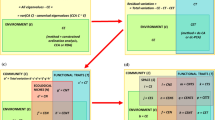Abstract
We present a multiviriate approach for the analysis of contigency tables involved in the study of species-environment relationships. The first table (species x sample) contains the abundance of p species collected in n samples. The second table (environment variables x sample) contains values for q environmental variables measured in the n samples. The third table contains the indication of ‘where’ and ‘when’ samples were taken.
In this paper we demonstrate: (1) how to match an environmental table and a faunistic table using co-inertia analysis; (2) how to take into account a spatial effect using between-class analyses; and (3) how to combine point (1) and (2) to determine the spatial structure shared by fauna and habitat.
We illustrate such an approach by using a set of hydrobiological data concerning 13 Ephemeroptera species and ten physical and chemical variables which were collected in the same site at the same dates in a small river of the Prealps.
Similar content being viewed by others
References
Beffy, J. L. & S. Dolédec, 1991. Mise en évidence d'une typologie spatiale dans le cas d'un fort effet temporel: un exemple en hydrobiologie. Bull. ecol. 22: 169–178.
Bornette, G., C. Amoros & D. Chessel, 1994. Rejuvenation in former braided channels of the Rhone River: successional patterns and allogenic processes. J. Veg. Sci. 5: 237–246.
Cazes, P., 1980. L'analyse de certains tableaux rectangulaires décomposés en blocs: généralisation des propriétés rencontrées dans l'étude des correspondances multiples. I. Définitions et applications à l'analyse canonique des variables qualitatives. Cah. de l'An. des Données 5: 145–161.
Chessel, D. & S. Dolédec, 1993. A.D.E. version 3.6: Hypercard Stacks & QuickBasic Microsoft Programme Library for the Analysis of Environmental data. User's manual. URA CNRS 1451, Université Lyon 1 (France), 725 pp.
Chessel, D. & P. Mercier, 1993. Couplage de triplets statistiques et liaisons espèces-environment in J. D. Lebreton and B. Asselain (eds), Biométrie et environment. Masson, in press.
Dolédec,S. & D. Chessel, 1987. Rythmes saisonniers et composantes stationnelles en milie aquatique. I. Description d'un plan d'observation complet par projection de variables. Acta Oecol., Oecol. Gen. 8: 403–426.
Dolédec, S. & D. Chessel, 1989. Rythmes saisonniers et compasantes stationnelles en milieu aquatique. II. Prise en compte et élimination d'effets dans un tableau faunistique. Acta Oecol., Oecol. Gen. 10: 207–232.
Dolédec, S. & D. Chessel, 1991. Recent developments in linear ordination methods for environmental sciences. Adv. Ecol. 1: 133–155.
Dolédec, S. & D. Chessel, 1994. Co-inertia analysis: an alternative method for studying species-environment relationships. Freshwat. Biol. 31: 277–294.
Johnson, R. K. & T. Wiederholm, 1989. Classification and ordination of profundal macroinvertebrate communities in nutrient poor, oligo-mesohumic lakes in relation to environmental data. Freshwat. Biol. 21: 375–386.
Lebreton, J. D., R. Sabatier, G. Banco & A. M. Bacou, 1991. Principal component and correspondence analyses with respect to instrumental variables: an overview of their role in studies of structure-activity and species-environment relationships. In Applied Multivariate Analysis in SAR and Environmental Studies, J. Devillers & W. Karcher (eds). Kluwer Academic Publishers: 85–114.
Mercier, P., D. Chessel & S. Dolédec, 1992. Complete correspondence analysis of an ecological profile data table: a central ordination method. Acta Oecol. 13: 25–43.
Pegaz-Mauret, D., 1980. Impact d'une perturbation d'origine organique sur avec le benthos. Thèse de 3ème cycle, Université Lylon 1 (Lylon), 130 pp.
Romane, F., 1972. Un exemple d'utilisation de l'analyse factorielle des correspondances en écologie végétale. In E. van der Maarel & R. Tüxen (eds), Basic problems and methods in phytosociology, Dr W. Junk Publishers, The Hague: 151–167.
Rutt, G. P., N. S. Weatherly & S. J. Ormerod, 1990. Relationships between the physicochemistry and macroinvertebrates of british upland streams: the development of modelling and indicators systems for predicting fauna and detecting acidity. Freshwat. Biol. 24: 463–480.
Storey, A. W., S. E. Bunn, P. M. Davies & D. H. Edward, 1990. Classification of the macroinvertebrate fauna of two rivers systems in southwestern australia in relation to physical and chemical parameters. Regulated Rivers 5: 217–232.
ter Braak, C. J. F., 1986. Canonical correspondence analysis: a new eigenvector technique for multivariate direct gradient analysis. Ecology 67: 1167–1179.
ter Braak, C. J. F., 1987. The analysis of vegetation-environment relationships by canonical correspondence analysis. Vegetatio 69: 69–77.
ter Braak, C. J. F., 1988. Partial Canonical Analysis. In: Classification and related methods of data analysis, H. H. Bock, (ed.). Elsevier Science Publishers: 551–558.
Towsend, C. R., A. G. Hildrew & J. Francis, 1984. Community structure in some southern English streams: the influence of physicochemical factors. Freshwat. Biol. 14: 297–310.
Tucker, L. R., 1958. An inter-battery method of factor analysis. Psychometrika 23: 111–134.
Wright, J. F., P. D. Armitage, M. T. Furse & D. Moss, 1989. Prediction of invertebrates communities using stream measurements. Regulated Rivers 4: 147–155.
Yoccoz, N. & D. Chessel, 1988. Ordination sous contraintes de relevés d'avifaune: élimination d'effets dans un plan d'observations à deux facteurs. C.R. acad. Sci. Paris 307: 189–194.
Author information
Authors and Affiliations
Rights and permissions
About this article
Cite this article
Franquet, E., Dolédec, S. & Chessel, D. Using multiviriate analyses for separating spatial and temporal effects within species-environment relationships. Hydrobiologia 300, 425–431 (1995). https://doi.org/10.1007/BF00024484
Issue Date:
DOI: https://doi.org/10.1007/BF00024484




